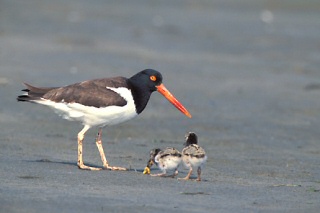|
Trail Guides
|
Cape May National Wildlife Refuge - Two Mile Beach Unit
|
1
 
|
Ocean Drive, Wildwood Crest, NJ
Phone: (609) 463-0994
www.fws.gov/northeast/capemay
U.S. Fish and Wildlife Service
Travel South on the Garden State Parkway to its end at a traffic light where Route 109 is on the Right. Go straight through the
light and turn Left at the next light onto CR 621/Ocean Dr. Follow Ocean Dr. 31⁄2 miles over
2 causeways and a toll bridge and turn Right
into the Refuge. Map
 |
| American Oystercatcher with chicks | Kevin Karlson |
| |
| | In 1999 the U.S. Coast Guard transferred ownership of Two Mile Beach to the U.S. Fish and Wildlife Service as part of Cape May National Wildlife Refuge. The 507 acre site is managed to protect one of the last remaining areas of undeveloped maritime forest and beach in New Jersey. The site has boardwalks and two observation platforms along with a 0.9 mile sand and clamshell trail that leads you through the maritime forest habitat. American Oystercatchers are often seen along the beach. Before entering the driveway from CR 621, you can pull off on
the shoulder and view the ponds on either side
of the road.
This is the best time of year to walk along the beach toward the jetty. If you scan the ocean while standing on the jetty, you might see Surf Scoter, winter ducks, cormorants and loons.
Scanning the ponds along Ocean Drive may yield good views of American Black Duck, Northern Pintail and wading birds, such as Greater and Lesser Yellowlegs, Whimbrel, Little Blue Heron, and Snowy Egrets.
Bottlenose dolphins may be seen traveling through the ocean not far from the beach.
From August to November, large numbers of songbirds use the forested habitats during migration; raptors can be seen flying overhead and seabirds can be viewed flying out over the ocean.
The maritime forest trail has educational signage for visitors. Once you enter the refuge off of Ocean Drive, take the first left into the parking lot. If you walk toward the beach, the entrance to the trail will be on your right. There is another trail access from the
second parking lot.
|
|
|